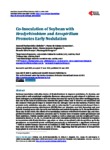Please use this identifier to cite or link to this item:
http://www.alice.cnptia.embrapa.br/alice/handle/doc/1019251| Title: | Co-inoculation of soybean with Bradyrhizobium and Azospirillum promotes early nodulation. |
| Authors: | CHIBEBA, A. M.  GUIMARÃES, M. de F.   BRITO, O. R.   NOGUEIRA, M. A.   ARAUJO, R. S.   HUNGRIA, M.   |
| Affiliation: | Amaral Machaculeha Chibeba, UEL; Maria de Fátima Guimarães, UEL; Osmar Rodrigues Brito, UEL; MARCO ANTONIO NOGUEIRA, CNPSO; Ricardo Silva Araujo, Total Biotecnologia Indústria e Comércio Ltda; MARIANGELA HUNGRIA DA CUNHA, CNPSO. |
| Date Issued: | 2015 |
| Citation: | American Journal of Plant Sciences, [S. l.], v. 6, n. 10, p. 1641-1649, Jun. 2015. |
| Description: | Soybean inoculation with elite strains of Bradyrhizobium to improve nodulation, N2 fixation, and grain yield is well established worldwide. However, when grown in soils where N is deficient, soybean undergoes an initial phase of N starvation that may last up to 20 days after seedling germination due to the lack of synchronism between the phase when seed N reserves are exhausted and the moment when plants begin to benefit from the nitrogen fixed by the bacteria. Practices that promote early nodulation may play a key role in reducing the N starvation period. Azospirillum is a plant growth promoting rhizobacteria (PGPR) that can stimulate root hair formation and root growth, creating more sites for early root infection and nodule formation by N2-fixing Bradyrhizobium spp. In this study, the effects of co-inoculating soybeans with Bradyrhizobium spp. and Azospirillum brasilense on nodulation precocity and N2 fixation were evaluated under greenhouse and field conditions. Nodule number and dry weight, as well as plant and root dry weight and N accumulated in shoots at 15, 18, 21, 24 and 30 days after emergence (DAE) were evaluated in response to inoculation with Bradyrhizobium spp. alone or when co-inoculated with Azospirillum sp. In the greenhouse, co-inoculated plants nodulated precociously as indicated by a significant increase (p< 0.05) in nodule biomass observed at (include) 21 DAE. More pronounced effects of co-inoculation were observed in the field as early as 18 DAE, suggesting that the presence of Azospirillum helps plants to overcome environmental stresses. |
| Thesagro: | Soja Fixação de nitrogênio Inoculante |
| NAL Thesaurus: | Nitrogen fixation Soybeans |
| ISSN: | 2158-2750 |
| DOI: | 10.4236/ajps.2015.610164 |
| Type of Material: | Artigo de periódico |
| Access: | openAccess |
| Appears in Collections: | Artigo em periódico indexado (CNPSO)  |
Files in This Item:
| File | Description | Size | Format | |
|---|---|---|---|---|
| AJPS2015063013320647.pdf | 321.89 kB | Adobe PDF |  View/Open |









